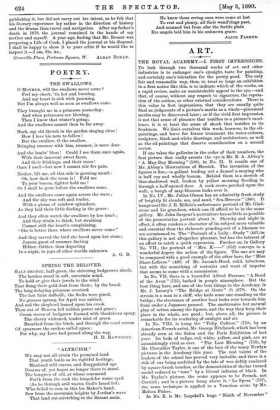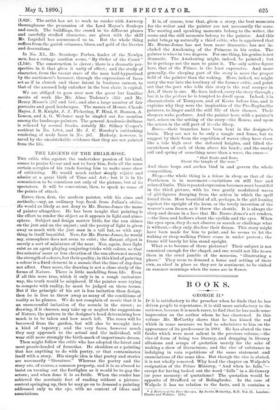ART.,
THE ROYAL ACADEMY.—I. FIRST IMPRESSIONS.. Tolook through two thousand works of art and other- industries is to endanger one's eyesight, taste for painting,, and certainly one's toleration for the pretty good. The only fair and reasonable way, then, to treat so large an exhibition. in a first notice like this, is to indicate which of the works, on a rapid review, make an unmistakable appeal to the eye,—and that, of course, without any respect to signature, the reputa- tion of the author, or other external considerations. There is this value in first impressions, that they are usually quite- final as judgments of a picture's merits as a whole—piecemeal merits may be discovered later; or if the vivid first impression is not that sense of pleasure that testifies to a picture's excel- lence, it is at least the sense of shock that testifies to its. freshness. We limit ourselves this week, however, to the oil- paintings, and leave for future treatment the water-colours, sculpture, black-and-white drawings, and architecture, as well as the oil-paintings that deserve consideration on a second review.
If one takes the galleries in the order of their numbers, the first picture that really arrests the eye is Mr. E. A. Abbey's " A May-Day Morning " (109), in No. II. It recalls one of Mr. Abbey's illustrations of Herrick. The invention of the figures is fine,—a gallant leading out a damsel a-maying who is half coy and wholly buxom. Behind them is a stretch of blue-shadowed wall, broken by yellow morning flooding in. through a half-opened door. A cock crows perched upon the wall; a bough of may-blossom looks over it.
In No. IV., Mr. Julius Olsson has an admirably fresh study of brightly lit clouds, sea, and sand, " Sea-Breezes " (360). It. hangs next Sir J. E. Millais's unfortunate portrait of Mr. Glad- stone and his grandson, which can ill afford to be in the same. gallery. gallery. Mr. John Sargent's portraiture has as little as possible of the presentation portrait about it. Sketchy and slight in effect, it often renders a character of its subject more valuable and essential than the elaborate grinding-out of a likeness we are accustomed to. The " Portrait of a Lady : Study " (421) in this gallery is not altogether pleasant, but has the interest of an effort to catch a quick expression. Further on, in Gallery No. VII., the portrait of " Mrs. X—" (652) conveys to a wonderful degree the action of the figure. The one art may be compared with a good example of the other here, the " Miss Shaw-Lefevre" (436) of Mr. Jacomb-Hood, solid, laborious, but with the something of restraint and want of impulse that seems to come with a commission.
In No. VII. there is a beautiful Alfred Parsons, "A Bend of the Avon" (715), bathed in purple atmosphere. But the best thing here, and one of the best things in the Academy, is Mr. J. Lavery's "The Bridge at Gretz " (P) (679). On the stream is a man in a skiff, who bails some one standing on the bridge ; the steersman of another boat looks over towards him from under a Japanese parasol. The unobtrusive but natural play of action among the figures, and the way they keep their• place in the whole, are good ; but, above all, the picture is remarkable for its rendering of sunlight and air.
In No. VIII. is hung the "Tulip Culture" (750), by an American-French artist, Mr. George Hitchcock, which has been already seen at the Salon and the Paris Exhibition of last year. Its beds of tulips, red, white, yellow, and pink, are as astonishingly vivid as ever. "The Last Blessing" (758), by Mr. Chevalier Tayler, is one of the best of the many Newlyn pictures in the Academy this year. The real talent of the leaders of the school has proved very imitable, and there is a. risk of our being surfeited by the tale of woe deftly rendered. by square-brush touches, or the domesticities of the tar turned model reduced to "tone" by a liberal infusion of black. In Mr. Tayler's picture, the scene appears to be French, not Cornish ; and in a picture hung above it, " La Sposa " (757), the same technique is applied to a Venetian scene by Mr. Melton Fisher.
In No. X. is Mr. Logsdail's huge " Ninth of November' (1,028). The artist has set to work to render with Antwerp thoroughness the procession of the Lord Mayor's flunkeys and coach. The buildings, the crowd in its different planes and carefully studied character, are given with the skill Mr. Logsdail has accustomed us to. But the whole thing suffers from the garish crimsons, blues, and gold of the liveries and decorations.
In No. XL, Mr. Stanhope Forbes, leader of the Newlyn men, has a cottage auction scene, " By Order of the Court" (1,146). The construction is clever ; there is a dramatic per- spective in it that gives it unity of effect; and the study of character, from the vacant stare of the man half-hypnotised by the auctioneer's hammer, through the expressions of faces set as if in church and those intent in business earnest, to that of the amused lady onlooker in the best chair, is capital.
We are obliged to pass over now the great but familiar merits of work like Mr. Alma Ta,dema's 324) and Mr. Henry Moore's (257 and 544), and also a large number of fair portraits and good landscapes. The names of Messrs. Claude Hayes, J. B. Knight, J. J. Pickering, F. Hind, S. Hansen, A. Lemon, and A. G. Webster may be singled out for mention among the landscape-painters. The general Academic dullness is relieved by several freaks, notably Mr. Sidney Cooper's accident in No. 1,004, and Mr. J. C. Horsley's unblushing rendering of nude faces in No. 267. Modesty, however, is saved by the unmistakable evidence that they are not painted from the life.







































 Previous page
Previous page